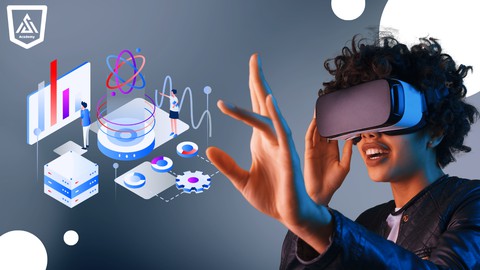
Data Science and Machine Learning: A Practical Guide
Data Science and Machine Learning: A Practical Guide, available at $74.99, has an average rating of 4.95, with 47 lectures, based on 46 reviews, and has 122 subscribers.
You will learn about Data Manipulation: Learn how to effectively manipulate and transform data using Python libraries such as Pandas, NumPy, and SciPy. Data Analysis: Develop the ability to explore and analyze datasets using Python's powerful data visualization libraries like Matplotlib and Seaborn. Gain hands-on experience in conducting EDA, including using tools like Pandas Profiling, DABL, and Sweetviz to analyze and visualize datasets. Master the essential concepts of Python programming, including data types, tuples, lists, dicts, basic operators, and functions. Gain an in-depth understanding of Data Science processes: data wrangling, data exploration, data visualization, hypothesis building, and testing Apply knowledge and actionable insights from data across a broad range of application domains. This course is ideal for individuals who are This course is designed for individuals who are interested in learning and applying data science techniques using the Python programming language. or Aspiring Data Scientists: Individuals who want to pursue a career in data science and want to gain practical skills in using Python for data analysis, modeling, and visualization. or Python Programmers: Programmers who are already familiar with Python and want to expand their knowledge to the field of data science. This course will help them apply their programming skills to solve real-world data problems. or Data Analysts: Analysts who work with data and want to enhance their skills by incorporating Python into their data analysis workflows. This course will enable them to perform more advanced data manipulation, statistical analysis, and visualization using Python. It is particularly useful for This course is designed for individuals who are interested in learning and applying data science techniques using the Python programming language. or Aspiring Data Scientists: Individuals who want to pursue a career in data science and want to gain practical skills in using Python for data analysis, modeling, and visualization. or Python Programmers: Programmers who are already familiar with Python and want to expand their knowledge to the field of data science. This course will help them apply their programming skills to solve real-world data problems. or Data Analysts: Analysts who work with data and want to enhance their skills by incorporating Python into their data analysis workflows. This course will enable them to perform more advanced data manipulation, statistical analysis, and visualization using Python.
Enroll now: Data Science and Machine Learning: A Practical Guide
Summary
Title: Data Science and Machine Learning: A Practical Guide
Price: $74.99
Average Rating: 4.95
Number of Lectures: 47
Number of Published Lectures: 47
Number of Curriculum Items: 47
Number of Published Curriculum Objects: 47
Original Price: $19.99
Quality Status: approved
Status: Live
What You Will Learn
- Data Manipulation: Learn how to effectively manipulate and transform data using Python libraries such as Pandas, NumPy, and SciPy.
- Data Analysis: Develop the ability to explore and analyze datasets using Python's powerful data visualization libraries like Matplotlib and Seaborn.
- Gain hands-on experience in conducting EDA, including using tools like Pandas Profiling, DABL, and Sweetviz to analyze and visualize datasets.
- Master the essential concepts of Python programming, including data types, tuples, lists, dicts, basic operators, and functions.
- Gain an in-depth understanding of Data Science processes: data wrangling, data exploration, data visualization, hypothesis building, and testing
- Apply knowledge and actionable insights from data across a broad range of application domains.
Who Should Attend
- This course is designed for individuals who are interested in learning and applying data science techniques using the Python programming language.
- Aspiring Data Scientists: Individuals who want to pursue a career in data science and want to gain practical skills in using Python for data analysis, modeling, and visualization.
- Python Programmers: Programmers who are already familiar with Python and want to expand their knowledge to the field of data science. This course will help them apply their programming skills to solve real-world data problems.
- Data Analysts: Analysts who work with data and want to enhance their skills by incorporating Python into their data analysis workflows. This course will enable them to perform more advanced data manipulation, statistical analysis, and visualization using Python.
Target Audiences
- This course is designed for individuals who are interested in learning and applying data science techniques using the Python programming language.
- Aspiring Data Scientists: Individuals who want to pursue a career in data science and want to gain practical skills in using Python for data analysis, modeling, and visualization.
- Python Programmers: Programmers who are already familiar with Python and want to expand their knowledge to the field of data science. This course will help them apply their programming skills to solve real-world data problems.
- Data Analysts: Analysts who work with data and want to enhance their skills by incorporating Python into their data analysis workflows. This course will enable them to perform more advanced data manipulation, statistical analysis, and visualization using Python.
Unlock the Power of Python for Data Science and Visualization
Welcome to a comprehensive Python programming course tailored by Selfcode Academy for data science and visualization enthusiasts. Whether you’re a beginner or looking to expand your skill set, this course will equip you with the knowledge you need.
Master the Python Basics:
-
Start from scratch with Python fundamentals.
-
Learn about variables, data types, and the logic behind programming.
-
Explore conditional statements and loops.
-
Dive into essential data structures like lists, tuples, dictionaries, and sets.
-
Discover the world of functions, including powerful lambda functions.
-
Get familiar with Object-Oriented Programming (OOP) concepts.
Python’s Role in Data Science:
-
Transition to data science seamlessly.
-
Manipulate dates and times using Python’s datetime module.
-
Tackle complex text patterns with regular expressions (regex).
-
Harness the power of built-in Python functions.
-
Embrace NumPy for efficient numerical computing.
-
Master Pandas and its data structures, including Series and DataFrames.
-
Acquire data cleaning skills to handle missing values and outliers.
-
Excel at data manipulation with Pandas, including indexing, grouping, sorting, and merging.
-
Dive into data visualization with Matplotlib to create compelling graphs.
Advanced Data Science and Visualization:
-
Uncover insights through Exploratory Data Analysis (EDA) techniques.
-
Automate data analysis with Pandas Profiling, DABL, and Sweetviz.
-
Perfect your data cleaning and preprocessing techniques.
-
Craft captivating visualizations using Seaborn.
-
Create various plots, from lines and areas to scatter and violin plots with Plotly.
-
Take your data to the map with geographical visualizations.
Statistics and Hypothesis Testing:
-
Dive into descriptive statistics, including central tendency and dispersion.
-
Master inferential statistics, covering sampling, confidence intervals, and hypothesis testing.
-
Learn to conduct hypothesis tests using Python libraries.
Capstone Project:
-
Apply your skills to a real-world data science project.
-
Define a business problem and structure your analysis.
-
Summarize your findings in a comprehensive report.
Upon completing this course, you’ll have a strong foundation in Python programming for data science and visualization. You’ll possess the expertise to clean, analyze, and visualize data, empowering you to make data-driven decisions confidently.
Don’t miss this opportunity to embark on your data science journey.
Enroll now and unleash the potential of Python for data exploration and visualization!
Course Curriculum
Chapter 1: Fundamentals of python
Lecture 1: Getting Started With Python
Lecture 2: String Basics
Lecture 3: String Operations
Lecture 4: Conditional Statements in Python
Lecture 5: Loops in Python
Lecture 6: Data Structures Basics
Lecture 7: List
Lecture 8: Tuple
Lecture 9: Dictonary
Lecture 10: Set
Lecture 11: Functions Basics
Lecture 12: Anonymous Function –Lambda Function
Lecture 13: Special Function
Lecture 14: Comprehensions
Lecture 15: In-Built Functions
Lecture 16: OOP –Basics
Lecture 17: OOP –Advance (Inheritance, Encapsulation, Polymorphism)
Chapter 2: Data Science with Python
Lecture 1: Date Time Module
Lecture 2: RegEx –Built In Functions
Lecture 3: RegEx –Meta Characters
Lecture 4: NumPy vs List
Lecture 5: NumPy –Basics
Lecture 6: NumPy –Operations
Lecture 7: Pandas –Basics
Lecture 8: Pandas –Header & Index
Lecture 9: Pandas –Columns
Lecture 10: Pandas –loc & iloc
Lecture 11: Pandas –GroupBy, Sorting, Counts
Lecture 12: Pandas –Merge & Concatenate
Lecture 13: Pandas –Datetime
Lecture 14: Pandas –Advanced (Seperators, Rename, String Functions)
Lecture 15: Matplotlib –Basics
Lecture 16: Matplotlib –Types of Graphs
Chapter 3: Data Cleaning
Lecture 1: Missing Values
Lecture 2: Outliers –Basics
Lecture 3: Outliers –Visualization
Lecture 4: Data Cleaning on Naukri Dataset
Chapter 4: Visualization
Lecture 1: Data Visualization –Basics
Lecture 2: Line and Area Plot
Lecture 3: Scatter, Box and Violin Plot
Lecture 4: Maps
Chapter 5: Statistics for Data Science
Lecture 1: Descriptive and Inferential Statistics
Lecture 2: Hypothesis Testing
Chapter 6: Exploratory Data Analysis (EDA)
Lecture 1: Pandas Profiling
Lecture 2: DABL and Sweetviz
Chapter 7: Capstone Project
Lecture 1: Capstone Project
Chapter 8: Practice Set
Lecture 1: Practice Sheet
Instructors
-
Selfcode Academy
Powered by 1stMentor
Rating Distribution
- 1 stars: 0 votes
- 2 stars: 0 votes
- 3 stars: 2 votes
- 4 stars: 5 votes
- 5 stars: 39 votes
Frequently Asked Questions
How long do I have access to the course materials?
You can view and review the lecture materials indefinitely, like an on-demand channel.
Can I take my courses with me wherever I go?
Definitely! If you have an internet connection, courses on Udemy are available on any device at any time. If you don’t have an internet connection, some instructors also let their students download course lectures. That’s up to the instructor though, so make sure you get on their good side!
You may also like
- Best Video Editing Courses to Learn in March 2025
- Best Music Production Courses to Learn in March 2025
- Best Animation Courses to Learn in March 2025
- Best Digital Illustration Courses to Learn in March 2025
- Best Renewable Energy Courses to Learn in March 2025
- Best Sustainable Living Courses to Learn in March 2025
- Best Ethical AI Courses to Learn in March 2025
- Best Cybersecurity Fundamentals Courses to Learn in March 2025
- Best Smart Home Technology Courses to Learn in March 2025
- Best Holistic Health Courses to Learn in March 2025
- Best Nutrition And Diet Planning Courses to Learn in March 2025
- Best Yoga Instruction Courses to Learn in March 2025
- Best Stress Management Courses to Learn in March 2025
- Best Mindfulness Meditation Courses to Learn in March 2025
- Best Life Coaching Courses to Learn in March 2025
- Best Career Development Courses to Learn in March 2025
- Best Relationship Building Courses to Learn in March 2025
- Best Parenting Skills Courses to Learn in March 2025
- Best Home Improvement Courses to Learn in March 2025
- Best Gardening Courses to Learn in March 2025






















